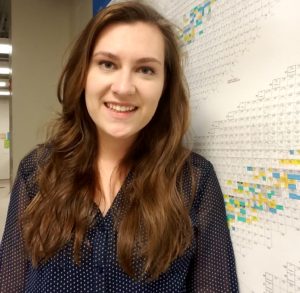Medical Physics Seminar – Monday, May 1, 2023
Antimony-119 Targeted Radionuclide Therapy

Aeli Olson
Graduate Research Assistant
Meitner Auger Electron (MAE) emitting radionuclides provide high radiation dose delivery (an advantage over clinical standard β-emitters), decay to stable isotopes providing simple dose tracking (an advantage over α-emitters), and can be produced on small cyclotrons networked across the world (an advantage over α-emitters which are very challenging to produce). Many in silico studies on MAE Targeted Radionuclide Therapy (TRT) promote Antimony-119 (119Sb) as an ideal TRT candidate due to the highly localized energy deposition of its 23-24 low energy MAEs, low x-ray emissions providing clean dose profile, and high cyclotron production yields. However, the lack of developed production technology and bifunctional chelator scaffolds have prevented application of this promising therapeutic radionuclide. We have developed 119Sb production capabilities including advancing target fabrication techniques and developing multiple chemical separation strategies to purify radioantimony from bulk cyclotron target material, leading to production of pre-clinical quality 119Sb. Additionally, reporting the first complexation of radioantimony with a bifunctional chelator, we've begun exploring biological application of targeted 119Sb within cellular and murine environments.
Imaging synaptic density using the PET radiotracer [11C]UCB-J in Alzheimer's disease and Down syndrome

Alexandra DiFilippo
Graduate Research Assistant
[11C]UCB-J is a PET radiotracer which binds to presynaptic vesicle glycoprotein SV2A with high specificity and has recently been used to study diseases and disorders that are implicated in alterations in brain structure such as Alzheimer's disease, schizophrenia, and Parkinson's disease. Imaging with this radiotracer has increased our understanding of pathophysiological changes in synaptic function in the brain. In Down syndrome, while there have been several studies observing changes in synaptic density in vitro, a pilot study using [11C]UCB-J acquired in vivo information about synaptic density in a younger adult Down syndrome cohort. In Alzheimer's disease, the extent to which amyloid-β and neurofibrillary tau tangle burden are associated with synaptic degeneration in vivo is not well known. PET imaging using [11C]UCB-J, [11C]PiB, and [18F]MK-6240 was used to examine the cross-sectional relationship between neurofibrillary tau tangle burden and amyloid-β plaque burden with synaptic density among individuals who spanned the clinical and biologic Alzheimer's disease continuum.